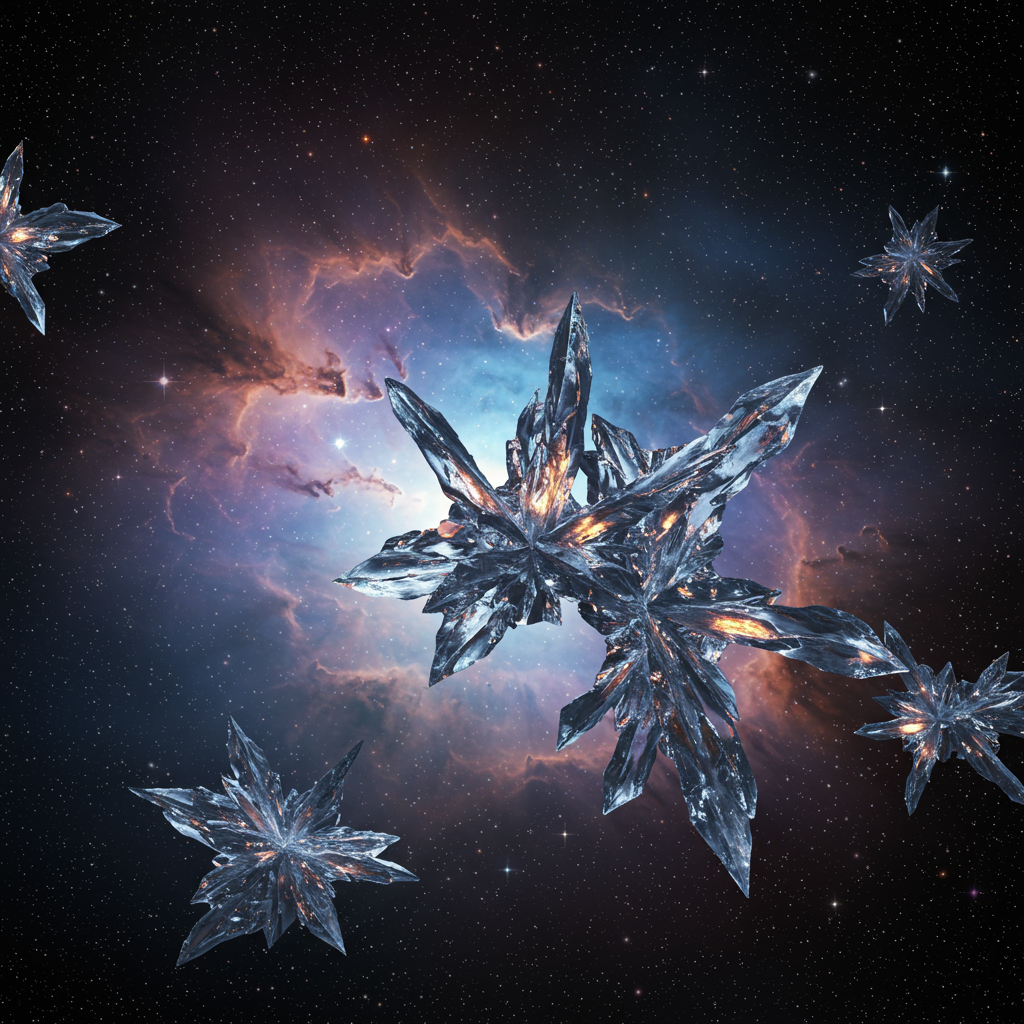Deep in the frigid expanse of space, where temperatures plummet far below anything seen on Earth, water exists primarily as ice. Scientists long believed this cosmic ice was almost entirely amorphous – a chaotic, disordered jumble of frozen molecules. This conventional wisdom held that the extreme cold simply didn’t allow water molecules enough energy to arrange themselves into neat, repeating crystalline structures. However, groundbreaking new research is challenging this fundamental understanding, revealing that even in the darkest, coldest corners of the universe, space ice likely contains tiny, embedded crystals. This unexpected finding is poised to change how we view water beyond Earth and its role in countless cosmic processes.
Unpacking the Nature of Cosmic Ice
Water, essential for life on Earth, behaves in surprisingly complex ways. On our relatively warm planet, water typically freezes into crystalline ice, characterized by a highly ordered atomic lattice, visible in the intricate symmetry of snowflakes. In contrast, the ultra-low temperatures and vacuum of space prevent water vapor from forming a liquid phase. Instead, it freezes directly onto surfaces like dust grains or asteroids, creating what was thought to be purely amorphous ice – a form lacking any long-range molecular order. This disordered state was considered a simple frozen snapshot of liquid water’s chaos.
Scientists identified over 20 different phases water can adopt under various pressures and temperatures. Broadly, these fall into the crystalline and amorphous categories. The prevailing scientific model strongly favored the amorphous form for the vast majority of ice found in the cold, dark interstellar medium and on icy bodies far from the Sun. The energy needed for molecules to migrate and align into a crystalline structure seemed prohibitively high given the ambient conditions of deep space.
Simulating and Experimenting with Frozen Water
Challenging this long-held belief, a research effort led by physicists Michael Benedict Davies and Christoph Salzmann employed a combination of cutting-edge computer simulations and laboratory experiments. Their goal was to investigate the structure of amorphous ice at the atomic level.
The simulations involved virtually freezing containers of water molecules. Researchers modeled freezing processes at temperatures around -120 degrees Celsius (-184 degrees Fahrenheit). They varied the freezing rates, knowing that how quickly water freezes impacts the resulting solid’s structure, influencing the proportion of amorphous versus crystalline regions. By comparing these simulation results to previous experiments using X-rays hurled at amorphous ice (a technique that reveals internal structure by how the beams scatter), the team found a compelling match. The simulation structure that best aligned with observed X-ray data wasn’t purely amorphous. Instead, it suggested a composition of roughly 20 percent tiny crystalline structures embedded within an 80 percent amorphous matrix.
To further test these findings, the researchers replicated space conditions in the laboratory. They created amorphous ice by depositing water vapor onto an extremely cold surface, mimicking how water vapor freezes directly onto cosmic dust or rock surfaces. They also created a higher-density amorphous ice by crushing conventional ice at very low temperatures. These laboratory-created ice samples were then gently warmed.
Scientists know that ice exhibits a form of ‘memory,’ particularly in the arrangement of its hydrogen atoms. This ordered arrangement from a previous crystalline state can sometimes persist even after transitioning to an amorphous phase. When the researchers warmed their amorphous ice samples, they observed structural changes that provided crucial evidence. If the ice were truly and completely amorphous from the start, warming it wouldn’t introduce new structural order in the way observed. The changes strongly indicated that the samples, despite appearing amorphous, contained pre-existing, trapped crystalline regions.
Why Tiny Space Crystals Matter
The presence of nanometer-sized crystals, or “crystallites,” within the vast ocean of amorphous cosmic ice is a significant discovery. It overturns the simplified atomic picture scientists had for the most common form of water in the universe. While the experiments were conducted under controlled conditions on Earth, the results provide compelling evidence that ice in the extreme cold of space is not merely a disordered jumble but likely incorporates these tiny crystalline pockets.
This altered understanding has wide-reaching implications across several fields of science.
Cosmic Catalysts: Impact on Astrophysics
Ice plays a surprisingly critical role in many large-scale cosmic processes. It forms icy mantles on interstellar dust grains, which are crucial for the formation of molecules in space. These dust grains then aggregate, forming planetesimals, the building blocks of planets. Understanding the precise structure of the ice on these grains could influence models of planet formation, including how water and other volatiles are delivered to rocky worlds. Furthermore, the movement and evolution of matter throughout galaxies and the large-scale evolution of galaxies themselves involve icy components. A more accurate atomic-level picture of space ice can refine our understanding of these complex astronomical phenomena.
Beyond Water: Insights into Amorphous Materials
The findings also extend beyond astrophysics, offering insights into amorphous materials in general. These materials, lacking the strict order of crystals, are vital components in numerous advanced technologies. For example, the glass fibers used in high-speed data transmission must be amorphous to function efficiently. The discovery that what appears amorphous might contain tiny crystalline inclusions raises questions about the fundamental nature of these materials. If these previously undetected crystallites exist in technological amorphous materials, understanding their presence and potentially finding ways to remove them could lead to improved performance in applications like fiber optics or novel glass compositions.
The research published in Physical Review B demonstrates that our understanding of seemingly simple substances like water ice remains incomplete, especially under conditions far removed from our everyday experience. It reminds us that the universe holds structural secrets even within its most common constituents.
Frequently Asked Questions
What is the main discovery about ice in space?
The core finding is that the most common form of ice in the universe, long thought to be purely amorphous (a disordered jumble of molecules) due to the extreme cold of space, actually contains tiny crystalline regions. These repeating molecular patterns, or crystallites, are likely embedded within the otherwise disordered structure of space ice. This challenges the previous scientific consensus.
Why was this discovery surprising to scientists?
Scientists previously believed that the ultra-low temperatures found in deep space would prevent water molecules from having enough energy to move and arrange themselves into ordered crystalline structures. The energy barrier to forming crystals was considered too high in such cold environments. The research provides evidence that crystallization occurs even under these seemingly prohibitive conditions, which was unexpected.
What are the implications of this finding about space ice?
This discovery has implications for both astrophysics and materials science. In astrophysics, understanding the precise structure of ice is crucial for models of planet formation, the evolution of galaxies, and how matter cycles through the universe, as ice plays a key role in these processes. In materials science, the finding raises questions about the nature of amorphous materials used in technology (like glass fibers) and suggests that understanding or removing tiny crystalline regions within them could potentially improve their performance.
Conclusion
The universe’s most prevalent form of frozen water is not as simple as we once thought. New research combining advanced simulations and laboratory experiments reveals that ice in the frigid, dark void of space, long considered purely amorphous and disordered, likely contains tiny pockets of crystalline structure. This surprising finding overturns a fundamental assumption about cosmic ice and highlights the unique and complex nature of water itself, even far from Earth. From influencing how planets form to potentially improving modern technologies, this deeper understanding of space ice’s true structure promises to reshape our scientific perspectives across multiple disciplines. The universe continues to reveal its secrets, one frozen molecule at a time.
Word Count Check: ~1020 words




